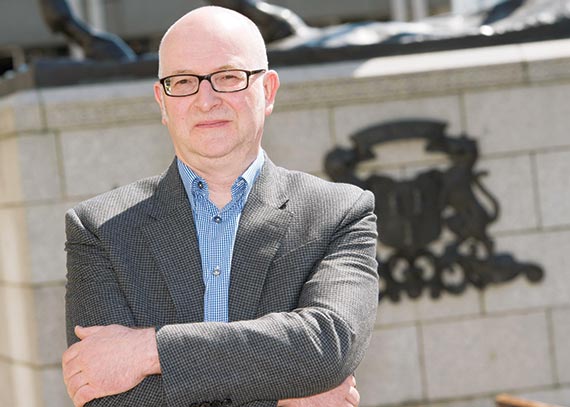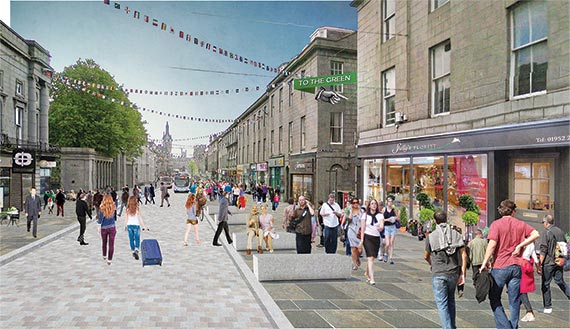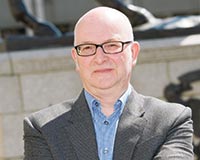 The Granite City, the oil capital of Europe, or just plain old Aberdeen? However it is viewed, the face of Aberdeen’s city centre is about to change.
The Granite City, the oil capital of Europe, or just plain old Aberdeen? However it is viewed, the face of Aberdeen’s city centre is about to change.
One year ago a new city centre masterplan by consultant BDP was approved by Aberdeen City Council, just as the crash in oil prices started to bite.
Fast-forward to February this year, when the council appointed regeneration specialist Marc Cole as its city centre director (see CV below). The £103,000-a-year post will see Cole provide leadership on all aspects of the city centre masterplan, a 25-year regeneration programme to help it reassert itself after years of underinvestment.
Four months into the role, the Bristol-born 53-year-old is keen to get things moving. In his first interview with the property press since taking on the new role, Cole says that the “vast majority” of the £1bn to be invested in capital build projects will come “mainly from the private sector”.
But is this wishful thinking, bearing in mind the difficult economic climate the city is facing, as the oil crisis leads to a reduction in appetite from investors and developers?
Cole remains bullish. “Aberdeen has not suffered a recession, we are seeing a rebalancing of the market. It has been tough but the underlying economic conditions still give us cause for optimism. Oil prices are edging upwards and we are talking to active investors looking to invest in the city centre.”
The masterplan includes game-changing schemes such as the £107m, 1m sq ft Marischal Square development. The council has teamed up with Muse Developments and funding partner Aviva to build a mixed-use scheme including offices, retail and a 126-bedroom Marriott Hotel.
Cole says: “There will be other schemes similar to Marischal Square where the local authority invests land or property – for example next to Marischal Square lies Queen’s Square, where the council also has assets. The project is key to the masterplan and will comprise a mixed-use residential and cultural quarter for the city.
“We are looking at land assembly for Queen’s Square now. In terms of scale, we are still scoping it out but it could include PRS development,” he says.
The council is “looking at every project on its own merits and different ways of bringing them forward,” says Cole.
Around 1.4m sq ft of offices are proposed in the masterplan. Of this, 375,000 sq ft is currently being, or has been, built speculatively. Cole says that any further spec development is unlikely to start until this space – at Marischal Square, The Capitol Building and Silver Fin – has all been let.
There is other tangible evidence of the masterplan at work. Cole cites the £30m redevelopment of Aberdeen Art Gallery and a £7m makeover of the Music Hall, which have either started or are about to start on site.
“We are also working on development briefs for the Station Gateway project and Denburn Valley – two key intervention areas in the masterplan,” he says.
Station Gateway will see much-needed remodelling of the area around Aberdeen railway station, including new commercial developments and a radically improved arrival experience into the city, connecting the area northwards to Union Street. Hammerson’s plans to extend its Union Square shopping mall next to the station will feed into this and also form a key part of the private sector involvement in the masterplan.
 Meanwhile, the Denburn Valley scheme will see a revitalisation of Union Terrace Gardens (see box) linking in to a new residential quarter for the city.
Meanwhile, the Denburn Valley scheme will see a revitalisation of Union Terrace Gardens (see box) linking in to a new residential quarter for the city.
While there is positivity in Aberdeen’s property market about the masterplan’s aspirations, there is also disquiet, with some market observers expressing disappointment that unlike Glasgow, which has the International Financial Services District, and Edinburgh, which has the Exchange District, Aberdeen city centre has no office core.
Cole disagrees. “There is provision for 1.4m sq ft of new offices in the masterplan. There has also been significant development of offices at the North Dee Business Quarter, which is the start of a city centre office core, and the masterplan builds on this.”
He adds: “There’s always a degree of cynicism when a big masterplan is launched. The only way to counter it is to deliver things and make sure people are linking them to the masterplan.
“We are rolling out the biggest regeneration programme in the city’s history and the opportunities are truly exciting.”
City Deal
Alongside the masterplan, Aberdeen won a £250m City Region Deal in January this year, which will see equal funding committed by the UK and Scottish governments for new housing and additional infrastructure projects for the city and its surrounds.
A new energy innovation centre and a £400m expansion of Aberdeen’s harbour are proposed. Although the City Deal does not fund this directly, it is investing in road infrastructure around the new harbour.
Richard Sweetnam, head of economic development at the council, says: “It is both a challenging and exciting time for Aberdeen. We recognise that the City Centre Masterplan and City Region Deal are both key mechanisms to deliver investment in the city and the wider regional economy. The governments, local councils and private sector partners are all working together to ensure that transport, innovation and digital elements of the city region deal are implemented as soon as possible.”
Market view
“The council is getting its act together and there are a lot of good projects in the masterplan, but my main concern is there is no one transformational project – like Dundee has the V&A. There is nothing that really stands out.”
Derren McRae, managing director (Aberdeen) CBRE
“I am really behind the city centre masterplan vision. But I hope it is not just rhetoric.”
Katherine Monro, partner, Knight Frank
“The challenge for the council is to reconcile priorities for funding and to progress ambitious bids for City Deal funding and a masterplan fund. Infrastructure will be key and this will require a new approach to car, bus, cycle and pedestrian priorities in and around Union Street.”
Richard Slipper, senior director, Bilfinger GVA
“The prevailing market conditions within the city have changed dramatically since publication of the final version of the masterplan in May 2015. The oversupply of space in the office sector was becoming evident in early 2015 following the start of the fall in oil prices in June 2014. It is difficult to see any major new office development being undertaken within the foreseeable future.”
Bruce Murdoch, partner, Graham + Sibbald
“Union Terrace Gardens presents a challenge. The Victorian sunken gardens are bordered by railway lines and a dual carriageway. Currently… it almost forms a barrier from one side of the city to the other.”
Catherine Thornhill, head of planning, Savills
“It is more important for the city to adopt a bold vision now for economic development, than during the high days of the boom, because of the need to diversify. Real estate will help Aberdeen do this.”
David Melhuish, director, Scottish Property Federation
Marc Cole CV
Born: Bristol, July 1963
Education: 1981 BA (Hons) in Town & Country Planning, University of the West of England. Diploma in Surveying, University of Reading
1986: Planning officer, Cheshire Council
1991: Principal economic development officer, Cheshire Council
1991: Deputy group leader, technical services department, Manchester Council
1997: Associate director, DTZ Pieda Consulting
1999: Deputy chief executive, Coalfields Regeneration Trust
2001: Head of regeneration, St Helens Council
2004: Director of regeneration, Bradford Centre Regeneration
2007: Chief executive of Nottingham Regeneration
2009: Strategic director for place, North East Lincolnshire Council
2014: Sets up own firm, Eastgate Consulting, working with various public and private sector clients
Feb 2016: Joins Aberdeen City Council as the new city centre director
Lifestyle: Commutes between family home in Yorkshire and Aberdeen. Enjoys live music, motorcycling and walking.
City centre masterplan – key facts
1.4m sq ft
of new office development proposed
730
new homes as part of the new residential quarter at the Torry Waterfront
49
projects within seven ‘intervention’ areas: Denburn Valley, Heart of the City, Queen’s Square, Union Street West, Station Gateway, Castlegate/Castlehill, North Dee/Torry Waterfront
20 years
the length of the regeneration programme
£3bn
generated by the masterplan for the wider Aberdeen City Region economy
3,000
new residents into the city centre
Source: Aberdeen City Council and City Centre Masterplansterplan











